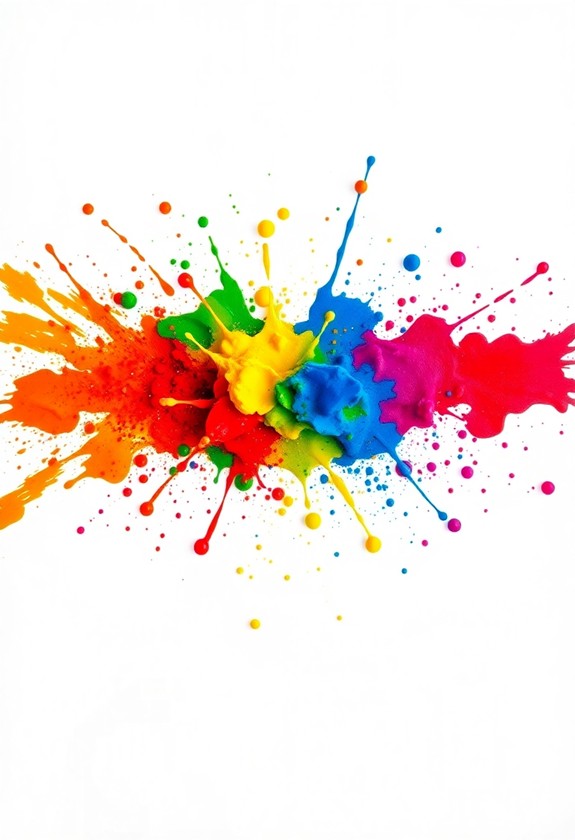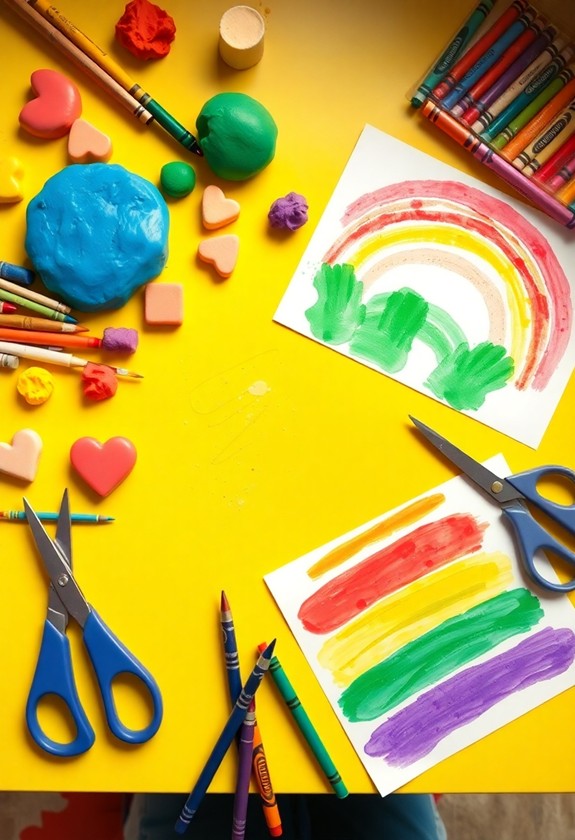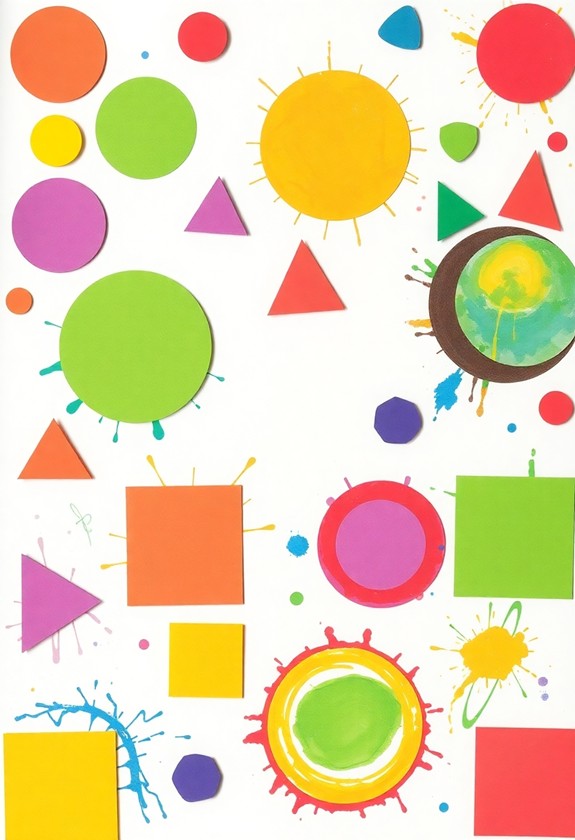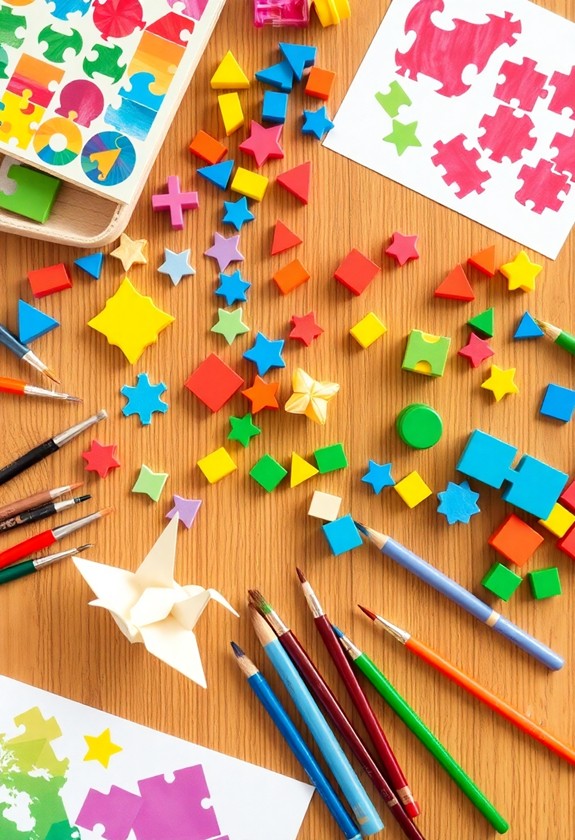Release your toddler's inner scientist with these 7 amazing color mixing experiments! From the mesmerizing Rainbow in a Jar to the magical Dancing Colors Milk Experiment, your little one will be enthralled. Watch flowers change hues in the Color-Changing Flowers activity, or create a mess-free masterpiece with Magical Color-Mixing Bags. Let them become mini-volcanologists with the Erupting Volcano Color Mixing, or observe capillary action in action with the Walking Water Rainbow. And for a creative twist, try Melting Crayon Art! These hands-on experiments teach color theory, basic chemistry, and plant anatomy as they spark curiosity and imagination. Get ready to discover a rainbow of scientific wonders!
Creative Highlights
- Rainbow in a Jar demonstrates color layering and density while enhancing memory retention and information processing.
- Dancing Colors Milk Experiment engages toddlers with swirling colors due to surface tension disruption.
- Color-Changing Flowers teach plant anatomy and environmental awareness through a visually appealing process.
- Magical Color-Mixing Bags provide a safe, mess-free sensory experience for exploring color combinations.
- Walking Water Rainbow showcases capillary action and color mixing, teaching patience in observation.
Rainbow in a Jar
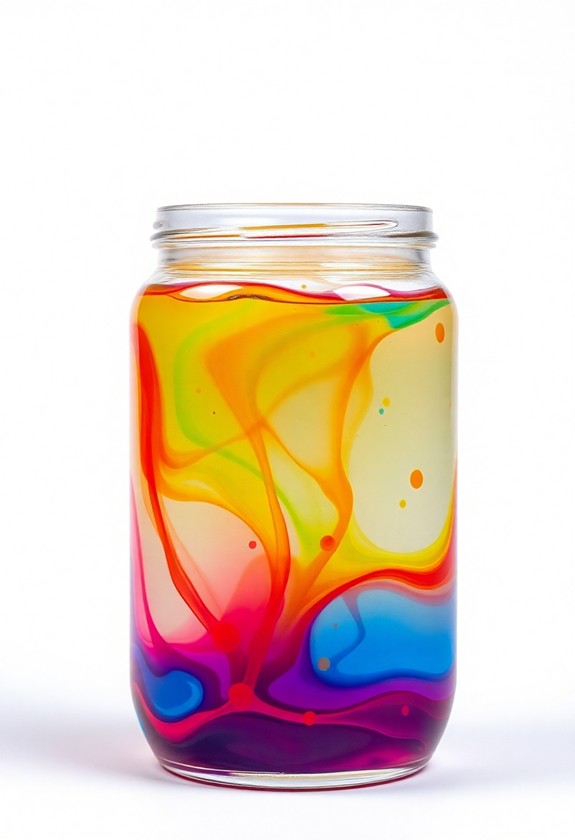
Three colorful liquids are all you need to create a stunning rainbow in a jar. It's like magic! Here's what you'll do:
- Grab a clear jar and three colors: red, yellow, and blue
- Mix each color with water and dish soap
- Carefully pour the red mixture first
- Then, s-l-o-w-l-y add the yellow
- Finally, gently pour in the blue
Watch in awe as the colors stay separate, creating a beautiful rainbow effect! This multi-sensory experience aids in memory retention and information processing, essential for early childhood development. But wait, there's more! Try these fun variations:
- Use different colors for a unique rainbow
- Add glitter for extra sparkle
- Experiment with layering order
This activity isn't just pretty – it's science in action! Your little one will learn about density during having a blast. And the best part? No mess, just colorful fun!
Dancing Colors Milk Experiment
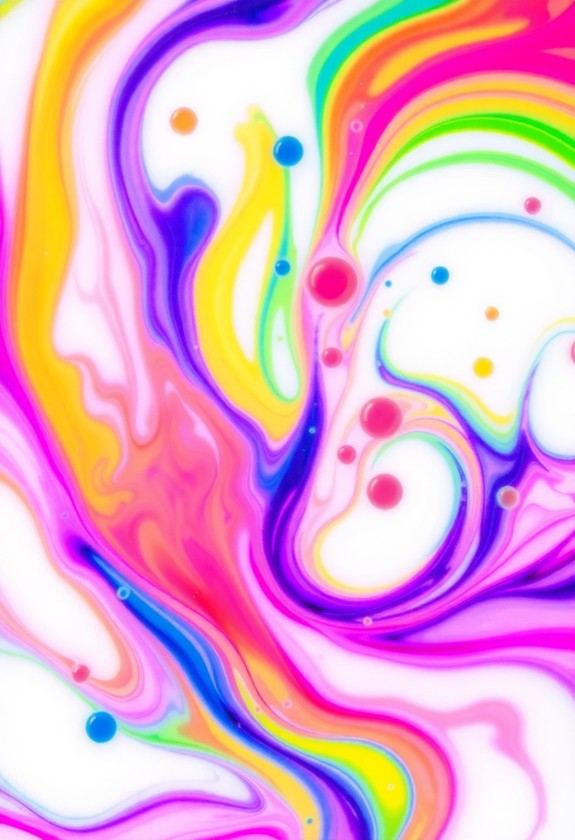
Get ready to witness colors come alive with the Dancing Colors Milk Experiment! This magical activity will have your little one squealing with delight as they watch colors swirl and twirl before their eyes. Here's what you'll need:
- A shallow dish filled with milk
- Food coloring (at least 3 colors)
- Dish soap and a cotton swab
Pour a thin layer of milk into the dish. Add drops of food coloring in different spots. Now, here's where the magic happens! Dip the cotton swab in dish soap and gently touch the milk's surface. Watch in awe as the colors start to move and swirl! It's like a colorful ballet in your kitchen! The secret? It's all about surface tension. The soap breaks it, causing the colors to chase each other. Your toddler will be mesmerized by this simple yet spectacular science show!
Color-Changing Flowers
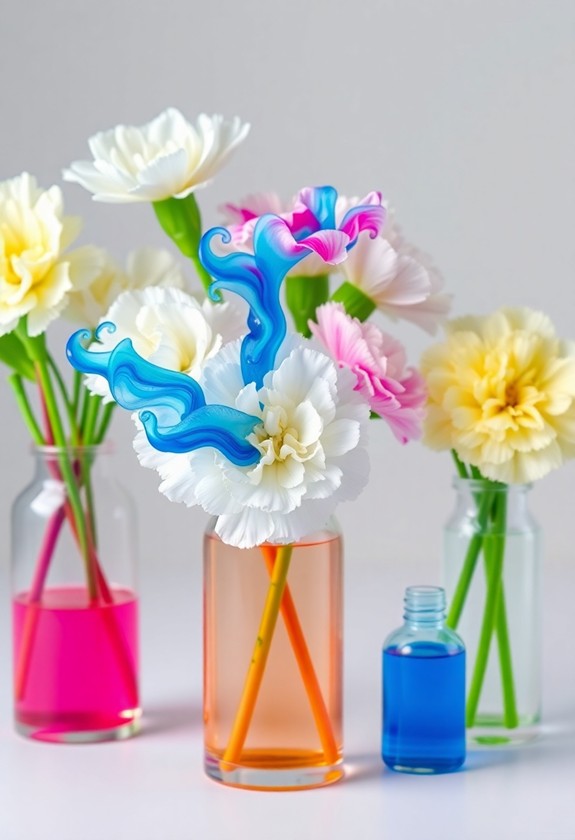
With the magic of nature and a dash of science, you can transform ordinary white flowers into a colorful rainbow display. It's like giving flowers a magical makeover! Here's how:
- Gather white carnations or daisies
- Fill separate glasses with water
- Add different food coloring to each glass
- Place one flower stem in each glass
Watch in awe as the flowers slurp up the colorful water through their stems. The petals will slowly change color, creating a stunning bouquet! This eco-friendly craft not only entertains but additionally encourages environmental awareness and connects children with nature. But wait, there's more! Try these fun variations:
- Split the stem and place each half in different colors
- Mix food coloring to create unique hues
- Use neon food coloring for extra-bright blooms
This blooming experiment is not only beautiful but also teaches kids about plant anatomy and water absorption. Get ready for a flower power party!
Magical Color-Mixing Bags
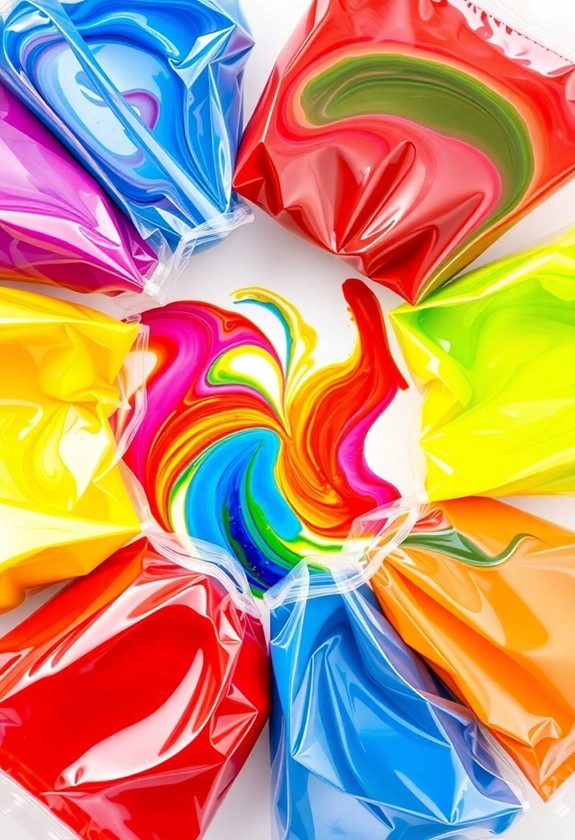
Countless toddlers are mesmerized by the magic of color mixing, and you can easily create a mess-free experience with magical color-mixing bags. Non-toxic ingredients guarantee safe investigation, making this activity perfect for young children who may still put things in their mouths. It's a brilliant way to investigate colors without the worry of stains or spills!
Here's how to make your own color-mixing sensation:
- Fill a ziplock bag with clear hair gel or hand sanitizer
- Add drops of different food coloring to the bag
- Seal it tightly and let the fun begin!
Watch your little one's eyes light up as they squish and squash the bag, creating swirls of lively hues! They'll be amazed at how red and yellow make orange, or blue and yellow create green. It's like a portable rainbow factory! Plus, it's a fantastic sensory activity that'll keep them engaged for hours. Who knew learning could be so colorful and exciting?
Erupting Volcano Color Mixing
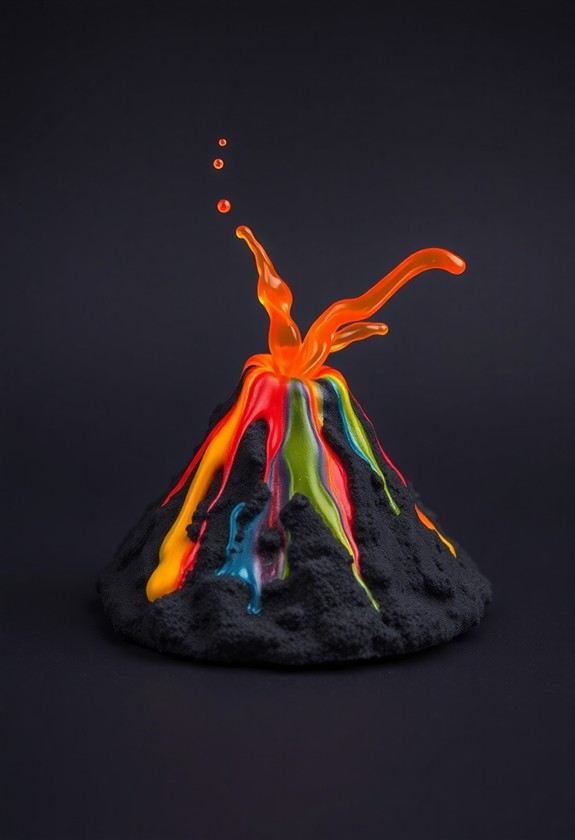
Why settle for ordinary color mixing when you can create an explosive experience? Welcome to the world of erupting volcano color mixing! This experiment will have your little ones squealing with delight as they watch colors bubble and fizz together. Safety precautions are crucial, so always supervise your toddlers during this activity and make certain they don't ingest any materials.
Here's what you'll need:
- Baking soda
- Vinegar
- Food coloring
- Small containers
- A tray or large bowl
Set up your "volcano" by placing small containers on a tray. Fill each with baking soda and different food coloring. Now, for the eruption! Let your toddler pour vinegar into each container and watch the colorful lava flow! As the mixtures bubble and merge, they'll create new hues right before your eyes.
This hands-on experiment isn't just fun – it's a fantastic way to teach color theory and basic chemistry. Plus, it's a blast to clean up!
Walking Water Rainbow
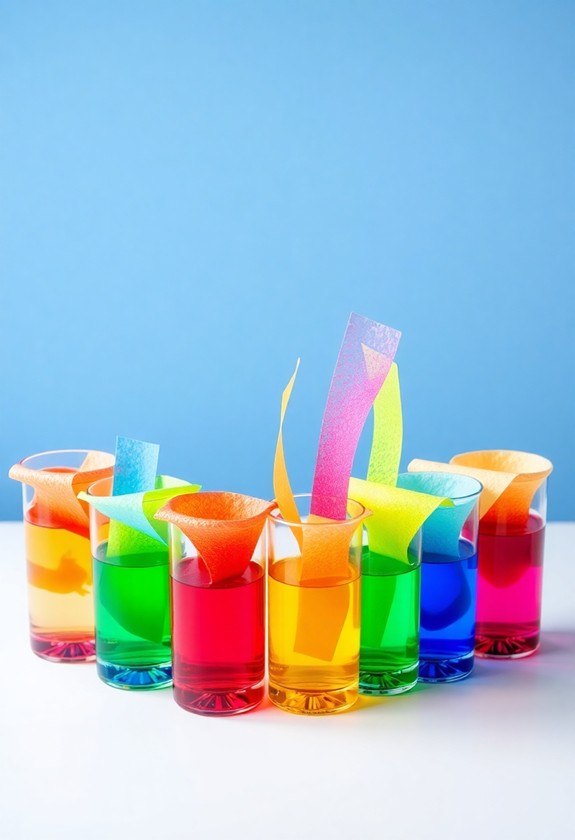
From simple to spectacular, the Walking Water Rainbow experiment will mesmerize your toddler's imagination. It's a colorful expedition that'll have your little one squealing with delight! This activity not only improves fine motor skills but additionally stimulates creative expression through hands-on learning. Here's what you'll need:
- Six clear glasses
- Paper towels
- Food coloring (red, yellow, and blue)
Fill every other glass with water and add different primary colors. Now, fold paper towels into strips and place them between the glasses, creating bridges. Watch in awe as the water "walks" up the paper towels and mixes colors in the empty glasses!
But wait, there's more! This isn't just fun—it's science in action. Your toddler will learn about:
- Capillary action
- Color mixing
- Patience (it takes time!)
Get ready for a rainbow of learning and laughter. It's time to let those colors walk and talk!
Melting Crayon Art

If you thought the Walking Water Rainbow was exciting, you'll love our next color mixing experiment! Get ready for some Melting Crayon Art magic!
Here's what you'll need:
- Crayons (various colors)
- Canvas or sturdy paper
- Hairdryer
- Adult supervision
Now, let's get colorful:
- Arrange crayons at the top of your canvas.
- Turn on the hairdryer (careful, it's hot!) and aim it at the crayons.
- Watch in awe as the crayons melt and create a rainbow waterfall!
- Tilt the canvas to guide the melting colors.
You'll be amazed at how the colors blend and swirl! It's like a crayon volcano erupting with creativity. This wax-cellent experiment is a guaranteed way to make art and science collide in a colorful explosion of fun!
Curious Little Questions
Are There Any Color-Mixing Experiments Suitable for Children With Color Blindness?
There are fantastic color-mixing experiments for kids with color blindness. You can focus on texture, sound, and smell instead of just color. Try:
- Mixing scented play dough
- Blending textured materials like sand and water
- Creating "sound paintings" with different instruments
These activities are just as fun and educational! Plus, they'll help develop other senses. Remember, every child is unique, and there's always a way to make science exciting for everyone. Let's get mixing and investigating!
How Can I Make Homemade Natural Dyes for These Experiments?
You can make awesome natural dyes at home, and it's so easy! Here's how:
- Use beets for red
- Try turmeric for yellow
- Boil red cabbage for purple
- Crush blueberries for blue
- Steep spinach for green
Just simmer your chosen ingredient in water, strain it, and voila! You've got lively, safe dyes for your color experiments. It's like magic in your kitchen! Plus, you're using things you can eat – how cool is that? Get ready to dye-ve into some colorful fun!
What Safety Precautions Should Be Taken During Color-Mixing Experiments With Toddlers?
Safety first, little scientists! When mixing colors with toddlers, you've got to be on your toes. Here's how to keep things fun and safe:
- Use non-toxic, edible materials only – think food coloring or veggie dyes
- Dress for mess! Wear old clothes or smocks
- Cover surfaces with newspapers or plastic
- Keep supplies out of reach when not in use
- Supervise closely – no taste-testing allowed!
- Have a clean-up station ready with wet wipes and towels
Can These Experiments Be Adapted for Larger Groups or Classrooms?
Did you know that 90% of teachers believe hands-on activities boost student engagement? You bet these experiments can be adapted for larger groups! It's a blast to scale up the fun. Try these ideas:
- Set up color-mixing stations around the room
- Divide kids into teams for a rainbow race
- Use bigger containers for more dramatic effects
And don't forget to amp up the excitement! Shout "Ready, set, mix!" and watch as your little scientists create a kaleidoscope of colors. It's gonna be amazing!
Are There Any Color-Mixing Activities That Incorporate Music or Movement?
You can turn color mixing into a rhythmic movement party! Try these fun ideas:
- Color Freeze Movement: Kids move with colored scarves, freezing to mix colors when the music stops.
- Rainbow Twirl: Spin with streamers of different colors, watching them blend as you move.
- Paint Drum Circle: Use different colored paints on drums, mixing as you play.
- Musical Color Splat: Toss colored water balloons on a canvas to the beat of the music.
These activities are certain to get those little scientists grooving and learning!

